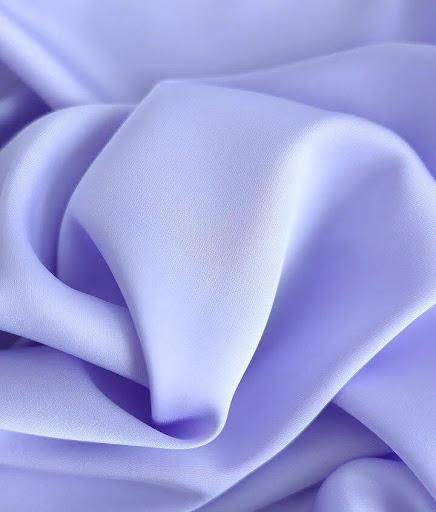Satin is a shiny and smooth fabric which is usually made of Polyester or Silk. It is used for creating evening wear or wedding gowns, thanks to its luxurious appearance. Satin has a rich history spanning many centuries.
WHAT IS SATIN?
Satin material is a stretchy, soft, silk-like fabric that is quite popular. It is highly versatile and reputed for its shiny and rich finish.
It is highly valued for its elegance and has a wide array of applications, from accessories and upholstery to interior design and apparel. Satin fabric is typically soft, lustrous and smooth. One side of the fabric is dull, while the other is shiny.
HISTORY OF SATIN
The fabric has a long and exciting history. Its name is derived from the Arabic word-‘ Zaitun’, which means- smooth.
China
The smooth and buttery texture of satin has its origins in ancient China. It dates back to two millennia ago, during the rule of the Han dynasty ( 206 BC to 220 AD). The ancient Chinese were well-versed in the skills of weaving and were masters in the art of the creation of silk fabric. Satin is a luxurious variant of this silk fabric. It was used mainly for ceremonial garments and clothing reserved for the elite classes, thanks to its lustrous and luxurious looks.
Middle East
In the Middle Ages, the art of satin production spread from China to the Middle East and from there to Europe via the trade on the Silk Road. The glossy finish of satin became popular among the upper classes and nobility throughout the Islamic world.
Renaissance Europe
Satin became highly popular in Renaissance Europe, where the fabric came to be used for interior decoration as well as apparel. Satin became highly sought after for its delicate texture and became a symbol of luxury and wealth. Initially permeating in Italy, the popularity of the fabric spread to all of Europe.
18th century
This century marked the rising production of silk in Europe, which led to better accessibility to satin fabric. Satin was popular with European nobility and monarchs, and it became to be much used in interior design and upholstery, often found in stately homes.
Industrial Revolution
This event in the 19th century led to progress in the manufacturing of textiles and the production of satin fabric. The evolution of power looms and innovative techniques of weaving made satin more accessible and available to a broader section of the populace.
Modern times
In the 20th and 21st centuries, satin has become used more widely, with the use of synthetic fibres such as acetate and polyester. The latter provides a much more cost-effective use than traditional silk satin. Satin is used nowadays for bedding, lingerie, formal wear, upholstery and jacket linings. Slipper satin is used for making footwear, while Duchesse satin is used for wedding attire and other formal wear.
FEATURES OF SATIN FABRIC
- Luxurious look and shininess
A significant attraction of satin fabric is its gorgeous, shiny surface. Its unique pattern of weaving creates a glossy and smooth finish which absorbs and reflects light attractively. This lustre differentiates satin from other fabrics. The result of a satin weave is a soft, shiny and flexible fabric with a lustrous drape. This can appeal to you while you are online fabric shopping in India.
- Gorgeous drape
The use of satin in the Middle Ages was mainly for curtains, evening wear and royal garments. The flexibility of the fabric and concentration of fibres used for weaving satin create a flowing and soft drape, ideal for delicate items.
- Durability
A weave of satin makes use of tightly woven filament fibres, creating a more robust material than the majority of plain weave fabrics. Items created from satin are typically long-lasting, highly resistant to soiling and long-enduring without any visible wear and tear.
- Wrinkle resistant
The satin fabric, significantly thicker satin, is a durable and robust fabric which is amazingly resistant to wrinkles. The reason is that satin tends to stretch out quickly and, hence, will not bunch.
- Smooth and comfortable
One unique quality of satin is that it is incredibly soft to the touch, making it a comfortable fabric for wearing at all times. The soft, silky texture of satin feels soothing against the skin; hence, it is used nowadays for creating nightwear, intimate apparel, and evening gowns. Such smooth texture of satin also minimises friction, rendering it gentle on skin and hair.
- Versatility
The fabric of satin is highly versatile and can be adapted to different uses. It is utilised in the fashion industry to make garments, lingerie, blouses, ties and other items of clothing. Satin is used also for home décor for upholstery, bedding, pillow covers and curtains. Being flexible, it can smoothly transition between casual and formal applications.
- Breathable
Some of the satin fabrics, which are made of natural fibres like silk satin, are breathable and permit air circulation. Such qualities are famous with regard to clothing material since it helps in the regulation of room temperature and prevention of excessive sweating. This makes it an ideal option for warm-weather attire.
- Intensity of colour
One prized quality of satin is that it can boost the vibrancy and intensity of colour. The fabric’s reflective surface causes a more vivid and richer appearance of colour. As such, satin is prized for use in colourful attire and furnishings.
- Ease of sewing
Satin is reputed for its ease of use in sewing applications. It is easy to work with, making it popular with amateur or professional sewists. The smooth surface of the fabric ensures the smooth gliding effect of sewing machines and less chances of puckering or snagging.
- Great variety
There are several varieties of satin, such as polyester satin, silk satin, antique stain, baronet satin, charmeuse satin, crepe back satin, duchesse satin, farmer’s satin, mescaline satin, slipper satin, sultan satin and surf satin.
Such diversity permits customers to select the best that matches their taste, style, budget and any specific needs. Each type of satin has its unique and creative design.
- Timeless beauty
Satin has a timeless appeal that will never fade with time. It has been used in furnishing and apparel designs for centuries and remains a symbol of sophistication and elegance.
In sum, satin fabric, with its rich history and versatile uses, continues to captivate popular sentiment. It has remained a symbol of luxury and opulence from ancient China till modern times. Both now and then, satin is prized for its versatility, beauty, wrinkle-resistance and its taut and durable nature.





